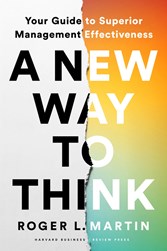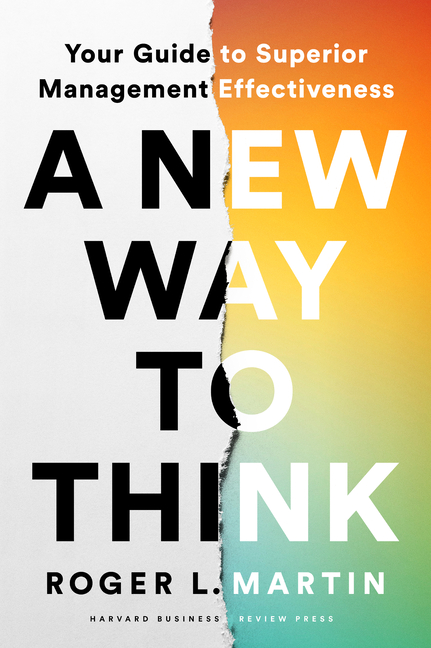A New Way to Think: Your Guide to Superior Management Effectiveness
April 29, 2022
A good book can change our minds. Roger Martin's new book strives to change fourteen outdated models our minds use to shape nearly everything we do in business.
 A New Way to Think: Your Guide to Superior Management Effectiveness by Roger L. Martin, Harvard Business Review Press
A New Way to Think: Your Guide to Superior Management Effectiveness by Roger L. Martin, Harvard Business Review Press
A good book can change someone’s mind. The right book at the right time can change someone’s life. That is true in the lives of our businesses, as well. If you’re here reading this, I’m sure you have experienced that reality. There is a reason you continue to look to books for ideas and inspiration. You know what is possible. You believe in possibilities, and in the power of a good book.
Roger Martin’s work has consistently provided proof of that power to me over the years. His new book tackles the outdated models we use to structure and run our businesses and offers new ways of thinking we can use to replace them. He proposes fourteen new models (or new ways to think) in all, dedicating a chapter to each, but I’ll focus on just a few areas here.
STAKEHOLDERS
We have covered many books about the flaws of shareholder maximization here over the years. It is a theory that has held sway in business for over forty years, and that has undermined businesses, markets, and our public life in the process. But Martin points to another casualty: the very shareholders the theory purports to benefit. As Martin sees it:
The harder a CEO is pushed to increase shareholder value, the more the CEO will be tempted to make moves that actually hurt the shareholders.
That is because managing shareholder expectations by managing (some might say manipulating) the stock price is a short-term game with short-term gains, and comes at the cost of managing the company itself. If you’re managing outsider’s expectations rather than inside operations, you are sacrificing real, “long term gains in operations-driven value” for “temporary gains in expectations-driven value.” Instead of focusing on shareholder value and expectations, finding out what customers value and meeting their expectations puts businesses on solid ground in the real economy. Shareholder value should be a happy byproduct of that focus, not the primary focus.
A far better approach is concentrating on serving customers. And it works. Martin shares the story of Paul Polman, who told shareholders soon after becoming CEO of Unilever that “he was going to put long-term innovation and branding ahead of short-term stock market considerations.”
Not only that, he would make Unilever a leader in sustainability, because consumers were going to increasingly demand it. And, if shareholders didn’t like his message, they should sell their stock. Many worried that the exit would crater Unilever’s stock and destroy the company. It didn’t. The stock traded down modestly. But the exiting shareholders were replaced by shareholders who cared about consumers long term and sustainability. Polman was widely considered to have turned around a lumbering giant and delivered a 266 percent increase in the stock price during his ten years at the helm—despite telling shareholders that they weren’t his singular obsession.
If you choose to manage the company and set it up to successfully serve customer needs over the long term, the stock price will take care of itself over the long term, too. The point is simple:
To actually create shareholder value, put your customers before your shareholders.
This insight applies to those of us in small businesses, as well, reminding us that consistently meeting customer expectations is the one sure way to ensure long-term success, sustainability, and business growth.
That said, understanding and meeting customer expectations is not necessarily an easy task. In a separate chapter on customers, Martin explains how purchasing decisions are usually determined more by habit than logic, by what’s comfortable rather than conscious consideration. True innovation requires exceeding expectations and creating something entirely new, which brings us to…
STRATEGY & DATA
When considering strategy, Martin suggests we focus not on what is currently true, but on what would have to be true for us to consider upending the status quo and change course. Rather than a well-structured analysis of current data, it is far more constructive to develop hypotheses—” or structured possibilities”—that can inform what direction to move the company. This frame is future-focused on new options and choices, and the analysis is then on future possibilities rather than current problems, in which we can easily become mired. As Martin writes:
Constructing strategic possibilities, especially ones that are genuinely new, is the ultimate creative act in business.
But there is a bit of a catch:
To generate such creative options, you need a clear idea of what constitutes a possibility. You also need an imaginative yet grounded team and a robust process for managing debate.
The pages in which Martin lays out the rules for this process are some of the most practical, yet inspiring in the book. We often tend to think of rules as constraints on creativity, but they are often exactly the opposite, and the framework he provides could be just what you need to put what seems like an unattainable or nebulous goal—a real, honest-to-goodness strategy session—well within reach.
He stresses how important it is to get a diverse array of people and specialties into this process, and to include operations in the mix. Martin also suggests you make sure that the most senior person involved does not serve as the group’s leader. Why? Well, as he writes:
If you show me a company where the planners are different from the doers, I will show you a company where what gets done is different from what was planned.
Inertia is a powerful force in organizational life. Including more perspectives and imagining what is possible shifts the conversation from what we believe now to what we would have to believe to overcome inertia and obstacles to new ideas and set a new course. This will likely make people uncomfortable, which Martin believes means you’re doing it right.
It is helpful here to characterize possibilities as stories, as there is no dataset available to determine whether something new has a chance of succeeding. Using a possibilities-based approach moves the discussion from “What should we do?” to “What might we do?” from “What do I believe?” to “What would I have to believe?” and from “What is the right answer?” to “What are the right questions? What specifically must we know in order to make a good decision?”
Living in the era of big data, we can become stuck in the notion that analyzing data is the only approach to understanding the world. That is unfortunate, because the world is full of possibilities that data about the past and present cannot reveal, that only inquiry, imagination, and inventive action can make real. “Creating great choices,” writes Martin, “requires imagination more than data.”
Martin extends this line of thinking by explaining how Aristotle, the father of the scientific method we have used to understand the natural world around, also wrote The Art of Rhetoric to describe how we might change the world through persuasion. Martin has seen how focusing on possibilities extends our understanding of the world beyond our current views and the current data, and helps managers overcome their personal bias by engaging their team:
In our experience, most managers are better at advocacy of their own views than at inquiry, especially about others’ views. The possibilities-based approach relies on and fosters a team’s ability to inquire. And genuine inquiry must lie at the heart of any process that aims to be scientific.
Martin cites pioneers of the computer industry alongside innovations like the railroad, motor car, and telephone as key examples, noting that while each relied on advances in science, they were all the products of imagination. He reminds us that “the absence of data does not preclude possibility” and that true innovation “requires the exercise of imagination—a very different process from analysis.”
Again, stories play a vital role:
Natural science explains the world as it is, but a story can describe a world that does not yet exist.
It is perhaps surprising then that Martin insists a critical part of the process is that, along with coming up with multiple new possibilities, one of the options that must be considered is the status quo:
I also insist that the status quo or current trajectory be among the possibilities considered. This forces the team in later stages to specify what must be true for the status quo to be viable, thereby eliminating the common implicit assumption “Worst case scenario, we can just keep doing what we’re already doing.”
As you may be gleaning by now, the book is both wide-ranging and ultra-specific in its subject matter. That means that no matter what kind of business, or what size company, you are in, there will be something of interest and actionable insight here for you. In my humble opinion, Martin doesn’t so much break new ground with his updated models as much as he gets us back to the basics of business, things we sense are true—maybe even self-evident—but have become obscured in our current business environment. To get a sense of what I mean, I’ll end where he begins, on…
COMPETITION
Because of Martin’s experience with P&G and other larger corporations, his examples are often focused on larger organizations, but the breadth and depth of the material provides lessons for all. For example, you may not have to worry about how to structure many layers of multiple business units or how to manage a complex corporate hierarchy, but Martin’s insight that competition “happens at the front lines more so that at the head office” is essential to understand for any size company. And if you work in a larger organization in which you do have to worry about those power dynamics, it is even more important to understand:
[L]eading businesses needs to be seen less as a challenge of managing organizational complexity and more about making sure that value is maximized at the front lines.
Corporate leaders tend to focus on competition at the company level, but customers are choosing between products—and in service businesses the people they enjoy working with—rather than companies. Big Tech has been more successful than most industries at locking us into the products and services they offer across platforms, but even there Martin reminds us that “Even though many Mac users like Microsoft’s Office suite, it doesn’t convert them to Windows.” We choose products that meet our needs, not companies to be loyal to, so:
It is up to the rest of the company to help the people on the front lines, where the revenue comes in, to satisfy those customer needs.
In his insistence that every level of a business’s most important work is to provide support and value to the level below it, Martin flips the paradigm of who we work for on its head. Our ultimate responsibility is not to those above us, but to support and serve those “below” us in the company hierarchy, those closest to the customer, and the customers themselves.
As I said at the beginning of this review, a good book can change someone’s mind. A New Way to Think can change the outdated models our minds use to shape nearly everything we do. So many of the improvements he suggests seem self-evident to me, but he provides ample evidence to back them up so you don’t have to take my word for it, or take them at face value. If you simply open up the book and open your mind, I believe they’ll make a difference. They may even change your life, or at least the life of your business.



